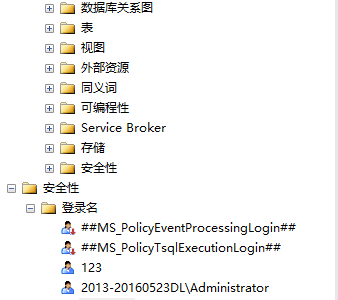android通过webservice连接SQL Server详细教程(数据库+服务器+客户端)这篇文章中讲到android如何通过webservice连接SQL Server。由于这篇文章距今也有四年了,一些代码在现在比较新的环境中运行不了。所以我根据评论中的提示和自己遇到的问题重新修改了部分代码,使得整个系统能在SQL Server2016+Win10+VS2015+android4.4上能够运行。具体的步骤就不说了,大致上和原来的教程差不多,只说几个比较容易出问题的地方。
1.原文章中登录SQL Server用的是Windows身份验证方式。如果像我出现登录失败的问题,可以改用SQL Server身份验证方式。在安全性-登录名中添加一个SQL Server身份验证方式登录的用户。
C#的代码里面数据库连接字符串还是粘贴属性里面的连接字符串,把密码改成自己的密码。
private String ConServerStr = "Data Source=2013-20160523DL;Initial Catalog=test;User ID=houjingyi;Password=*******";
2.一定要先在webservice里面确认对数据库的操作没有问题,再去调android程序。只看到页面出来了很可能数据库连接有问题,这样即使android程序没问题也调不出来。
3.android4.0以后不允许在主线程中访问网络,因为万一主线程阻塞了,会使得界面没有响应。我们开启线程访问即可。
public List<HashMap<String, String>> getAllInfo(final Handler myhandler)
{
HashMap<String, String> tempHash = new HashMap<String, String>();
List<HashMap<String, String>> list = new ArrayList<HashMap<String, String>>();
tempHash.put("Cno", "Cno");
tempHash.put("Cname", "Cname");
tempHash.put("Cnum", "Cnum");
list.clear();
arrayList1.clear();
arrayList2.clear();
arrayList3.clear();
list.add(tempHash);
new Thread()
{
public void run()
{
arrayList1 = Soap.GetWebServer("selectAllCargoInfor", arrayList1, arrayList2);
Message msg=new Message();
msg.what=0x123;
msg.obj=arrayList1;
myhandler.sendMessage(msg);
}
}.start();
return list;
}
public void insertCargoInfo(String Cname, String Cnum)
{
arrayList1.clear();
arrayList2.clear();
arrayList1.add("Cname");
arrayList1.add("Cnum");
arrayList2.add(Cname);
arrayList2.add(Cnum);
new Thread()
{
public void run()
{
try
{
Soap.GetWebServer("insertCargoInfo", arrayList1, arrayList2);
}
catch(Exception e)
{
}
}
}.start();
}
public void deleteCargoInfo(String Cno)
{
arrayList1.clear();
arrayList2.clear();
arrayList1.add("Cno");
arrayList2.add(Cno);
new Thread()
{
public void run()
{
try
{
Soap.GetWebServer("deleteCargoInfo", arrayList1, arrayList2);
}
catch(Exception e)
{
}
}
}.start();
}
final Handler myhandler=new Handler()
{
public void handleMessage(Message msg)
{
if(msg.what==0x123)
{
ArrayList<String> drrayList=(ArrayList<String>) msg.obj;
for(int j=0;!drrayList.isEmpty()&&j+2<drrayList.size();j+=3)
{
HashMap<String,String> hashMap=new HashMap<String,String>();
hashMap.put("Cno", drrayList.get(j));
hashMap.put("Cname", drrayList.get(j+1));
hashMap.put("Cnum", drrayList.get(j+2));
list.add(hashMap);
}
adapter=new SimpleAdapter(
MainActivity.this,list,
R.layout.adapter_item,
new String[]{"Cno","Cname","Cnum"},
new int[]{R.id.txt_Cno,R.id.txt_Cname,R.id.txt_Cnum});
listView.setAdapter(adapter);
}
}
};selectAllCargoInfo:
请求:
POST /Service1.asmx HTTP/1.1
Host: localhost
Content-Type: text/xml; charset=utf-8
Content-Length: length
SOAPAction: "http://tempuri.org/selectAllCargoInfor"
<?xml version="1.0" encoding="utf-8"?>
<soap:Envelope xmlns:xsi="http://www.w3.org/2001/XMLSchema-instance" xmlns:xsd="http://www.w3.org/2001/XMLSchema" xmlns:soap="http://schemas.xmlsoap.org/soap/envelope/">
<soap:Body>
<selectAllCargoInfor xmlns="http://tempuri.org/" />
</soap:Body>
</soap:Envelope>
响应:
HTTP/1.1 200 OK
Content-Type: text/xml; charset=utf-8
Content-Length: length
<?xml version="1.0" encoding="utf-8"?>
<soap:Envelope xmlns:xsi="http://www.w3.org/2001/XMLSchema-instance" xmlns:xsd="http://www.w3.org/2001/XMLSchema" xmlns:soap="http://schemas.xmlsoap.org/soap/envelope/">
<soap:Body>
<selectAllCargoInforResponse xmlns="http://tempuri.org/">
<selectAllCargoInforResult>
<string>string</string>
<string>string</string>
</selectAllCargoInforResult>
</selectAllCargoInforResponse>
</soap:Body>
</soap:Envelope>
insertCargoInfo:
请求:
POST /Service1.asmx HTTP/1.1
Host: localhost
Content-Type: text/xml; charset=utf-8
Content-Length: length
SOAPAction: "http://tempuri.org/insertCargoInfo"
<?xml version="1.0" encoding="utf-8"?>
<soap:Envelope xmlns:xsi="http://www.w3.org/2001/XMLSchema-instance" xmlns:xsd="http://www.w3.org/2001/XMLSchema" xmlns:soap="http://schemas.xmlsoap.org/soap/envelope/">
<soap:Body>
<insertCargoInfo xmlns="http://tempuri.org/">
<Cname>string</Cname>
<Cnum>int</Cnum>
</insertCargoInfo>
</soap:Body>
</soap:Envelope>
响应:
HTTP/1.1 200 OK
Content-Type: text/xml; charset=utf-8
Content-Length: length
<?xml version="1.0" encoding="utf-8"?>
<soap:Envelope xmlns:xsi="http://www.w3.org/2001/XMLSchema-instance" xmlns:xsd="http://www.w3.org/2001/XMLSchema" xmlns:soap="http://schemas.xmlsoap.org/soap/envelope/">
<soap:Body>
<insertCargoInfoResponse xmlns="http://tempuri.org/">
<insertCargoInfoResult>boolean</insertCargoInfoResult>
</insertCargoInfoResponse>
</soap:Body>
</soap:Envelope>
deleteCargoInfo:
请求:
POST /Service1.asmx HTTP/1.1
Host: localhost
Content-Type: text/xml; charset=utf-8
Content-Length: length
SOAPAction: "http://tempuri.org/deleteCargoInfo"
<?xml version="1.0" encoding="utf-8"?>
<soap:Envelope xmlns:xsi="http://www.w3.org/2001/XMLSchema-instance" xmlns:xsd="http://www.w3.org/2001/XMLSchema" xmlns:soap="http://schemas.xmlsoap.org/soap/envelope/">
<soap:Body>
<deleteCargoInfo xmlns="http://tempuri.org/">
<Cno>string</Cno>
</deleteCargoInfo>
</soap:Body>
</soap:Envelope>
响应:
HTTP/1.1 200 OK
Content-Type: text/xml; charset=utf-8
Content-Length: length
<?xml version="1.0" encoding="utf-8"?>
<soap:Envelope xmlns:xsi="http://www.w3.org/2001/XMLSchema-instance" xmlns:xsd="http://www.w3.org/2001/XMLSchema" xmlns:soap="http://schemas.xmlsoap.org/soap/envelope/">
<soap:Body>
<deleteCargoInfoResponse xmlns="http://tempuri.org/">
<deleteCargoInfoResult>boolean</deleteCargoInfoResult>
</deleteCargoInfoResponse>
</soap:Body>
</soap:Envelope>
其实这个类就是在GetWebServer先拼XML格式的POST请求发给页面,然后在StreamtoValue里面对返回的数据做解析。GetWebServer这个函数比较简单,而在StreamtoValue里面要根据返回类型的不同执行不同的操作。删除和插入操作返回的是布尔类型,而查询操作返回的是String和int。我们也可以看到,删除和插入操作返回的XML格式是一样的。相信大家对比着XML和注释就能明白。
package com.bottle.stockmanage;
import java.io.IOException;
import java.io.InputStream;
import java.io.OutputStream;
import java.net.HttpURLConnection;
import java.net.URL;
import java.util.ArrayList;
import android.app.Activity;
import android.net.ConnectivityManager;
import android.widget.Toast;
public class HttpConnSoap
{
public ArrayList<String> GetWebServer(String MethodName, ArrayList<String> Parameters, ArrayList<String> ParValues)
{
ArrayList<String> Values = new ArrayList<String>();
//在android模拟器中测试填写10.0.2.2
//在真机中测试填写电脑的IP地址
String ServerUrl = "http://10.8.167.229:6666/Service1.asmx";
String soapAction = "http://tempuri.org/" + MethodName;
String soap = "<?xml version=\"1.0\" encoding=\"utf-8\"?>"
+ "<soap:Envelope xmlns:xsi=\"http://www.w3.org/2001/XMLSchema-instance\" xmlns:xsd=\"http://www.w3.org/2001/XMLSchema\" xmlns:soap=\"http://schemas.xmlsoap.org/soap/envelope/\">"
+ "<soap:Body />";
String s1, s2, s3, s4 = "";
s4 = "<" + MethodName + " xmlns=\"http://tempuri.org/\">";
for (int i = 0; i < Parameters.size(); i++)
{
s1 = Parameters.get(i).toString();
s2 = ParValues.get(i).toString();
s3 = "<" + s1 + ">" + s2 + "</" + s1 + ">";
s4 = s4 + s3;
}
s4 = s4 + "</" + MethodName + ">";
String s5 = "</soap:Envelope>";
String requestData = soap + s4 + s5;
try
{
URL url = new URL(ServerUrl);
HttpURLConnection con = (HttpURLConnection) url.openConnection();
byte[] bytes = requestData.getBytes("utf-8");
con.setDoInput(true);
con.setDoOutput(true);
con.setUseCaches(false);
con.setConnectTimeout(6000);
con.setRequestMethod("POST");
con.setRequestProperty("Content-Type", "text/xml;charset=utf-8");
con.setRequestProperty("SOAPAction", soapAction);
con.setRequestProperty("Content-Length", "" + bytes.length);
OutputStream outStream = con.getOutputStream();
outStream.write(bytes);
outStream.flush();
outStream.close();
InputStream inStream = con.getInputStream();
Values = StreamtoValue(inStream, MethodName);
return Values;
}
catch (Exception e)
{
return null;
}
}
public ArrayList<String> StreamtoValue(InputStream in, String MethodName) throws IOException
{
StringBuffer out = new StringBuffer();
String s1 = "";
byte[] b = new byte[4096];
ArrayList<String> Values = new ArrayList<String>();
Values.clear();
for (int n; (n = in.read(b)) != -1;)
{
s1 = new String(b, 0, n);
out.append(s1);
}
System.out.println(out);
//分割
String[] s2 = s1.split("><");
String s5 = MethodName + "Result";
String s3 = "",s4 = "";
Boolean getValueBoolean = false;
for (int i = 0; i < s2.length; i++)
{
s3 = s2[i];
System.out.println(s3);
int FirstIndexPos, LastIndexPos, LengthofS5;
FirstIndexPos = s3.indexOf(s5);
LastIndexPos = s3.lastIndexOf(s5);
/*
删除:deleteCargoInfoResult>boolean</deleteCargoInfoResult
插入:insertCargoInfoResult>boolean</insertCargoInfoResult
查询:
selectAllCargoInforResult
string>string</string
string>string</string
/selectAllCargoInforResult
*/
if (FirstIndexPos >= 0)
{
if (getValueBoolean == false)
{
getValueBoolean = true;
}
//如果返回的是布尔值,对应删除和增加操作
if ((FirstIndexPos >= 0) && (LastIndexPos > FirstIndexPos))
{
LengthofS5 = s5.length() + 1;
s4 = s3.substring(FirstIndexPos + LengthofS5, LastIndexPos - 2);
Values.add(s4);
getValueBoolean = false;
return Values;
}
}
//查询操作取值结束
if (s3.lastIndexOf("/" + s5) >= 0)
{
getValueBoolean = false;
return Values;
}
//如果返回的不是布尔值,对应查询操作
if ((getValueBoolean) && (s3.lastIndexOf("/" + s5) < 0) && (FirstIndexPos < 0))
{
LastIndexPos = s3.length();
s4 = s3.substring(7, LastIndexPos - 8);
Values.add(s4);
}
}
return Values;
}
} 6.如果你的电脑和我一样使用的是局域网,那么手机必须连和电脑在同一个网段的WIFI,不能用4G或者3G连接。如果你用的是公网IP或者以后把程序发布到一个服务器上从而获得一个公网IP,就没有这个限制了。
最后欢迎大家一起交流,学习,也感谢原作者的文章。修改后可运行的代码在:https://github.com/houjingyi233/android-connect-to-SQL-Server-On-PC-by-webservice/
























 2410
2410

 被折叠的 条评论
为什么被折叠?
被折叠的 条评论
为什么被折叠?








